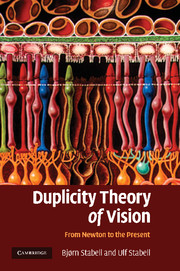Book contents
- Frontmatter
- Contents
- Acknowledgements
- 1 Introduction
- Part I The development of the basic ideas of the duplicity theory from Newton to G. E. Müller
- Part II The development of the duplicity theory from 1930–1966
- Part III Chromatic rod vision: a historical account
- 11 Night vision may appear bluish
- 12 Mechanisms of chromatic rod vision in scotopic illumination
- 13 Rod-cone interactions in mesopic vision
- 14 Further exploration of chromatic rod vision
- Part IV Theories of sensitivity regulation of the rod and cone systems: a historical account
- Part V Factors that triggered the paradigm shifts in the development of the duplicity theory
- References
- Index
12 - Mechanisms of chromatic rod vision in scotopic illumination
Published online by Cambridge University Press: 22 January 2010
- Frontmatter
- Contents
- Acknowledgements
- 1 Introduction
- Part I The development of the basic ideas of the duplicity theory from Newton to G. E. Müller
- Part II The development of the duplicity theory from 1930–1966
- Part III Chromatic rod vision: a historical account
- 11 Night vision may appear bluish
- 12 Mechanisms of chromatic rod vision in scotopic illumination
- 13 Rod-cone interactions in mesopic vision
- 14 Further exploration of chromatic rod vision
- Part IV Theories of sensitivity regulation of the rod and cone systems: a historical account
- Part V Factors that triggered the paradigm shifts in the development of the duplicity theory
- References
- Index
Summary
ALL PRINCIPLE HUES MAY BE OBSERVED IN SCOTOPIC VISION
A test of the prediction was carried out by Stabell and Stabell (1965). The successive phases of the experiment were as follows: (1) Dark adaptation for 30 min. (2) Pre-stimulation extrafoveally for 30 s using one of several colour filters in front of the eye at an intensity 1 log unit above the specific-hue threshold measured for the filter used. (3) Dark adaptation for 30 s. (4) Test stimulation at scotopic intensity levels in the pre-stimulated area using a green monochromatic test light.
Pre-stimulation with a red colour filter produced a blue colour upon the scotopic test stimulation, a yellow pre-stimulation filter produced blue or blue-violet, a green filter, blue-violet or violet, while blue and blue-green filters did not produce any chromatic effect upon scotopic test stimulation.
The reason for the failure to produce red, yellow and green scotopic contrast colours soon became apparent in a follow-up study where it was found that by increasing the level of chromatic adaptation (i.e. increasing the time of pre-stimulation, reducing the time interval between pre- and test stimulation, and increasing the size of the pre- and test-fields) scotopic red, orange and green colours could be produced. Thus, pre-stimulation with a green-blue colour produced a red colour upon test stimulation at scotopic intensities, a blue colour produced orange, and a purple colour produced a blue-green colour.
Information
- Type
- Chapter
- Information
- Duplicity Theory of VisionFrom Newton to the Present, pp. 113 - 119Publisher: Cambridge University PressPrint publication year: 2009
